| 产品编号 | 产品名称 | 产品规格 | 产品等级 | 产品价格 |
| MBG-PMW20-1001 | Mebiol ® Gel 温敏性水溶胶 |
1×10 mL | – | – |
| MBG-PMW20-1005 | Mebiol ® Gel 温敏性水溶胶 |
5×10 mL | – | – |
| MBG-PMW20-5001 | Mebiol ® Gel 温敏性水溶胶 |
1×50 mL | – | – |
| MBG-PMW20-5005 | Mebiol ® Gel 温敏性水溶胶 |
5×50 mL | – | – |
可用于3D细胞培养和其他领域
PNIPAAm-PEG;聚N-异丙基丙烯酰胺和聚乙二醇的嵌段共聚物
水凝胶具有聚合材料的多种特征,如网络结构和高含水量,目前他广泛的运用于医药生命科学等多种领域,但不仅限于3D培养、组织工程和药物传送这些。聚N-异丙基丙烯酰胺和聚乙二醇的嵌段共聚物早在2000年初就已经商业化,研究证明,Mebiol® Gel的特性使其非常适合应用于细胞培养和组织工程。
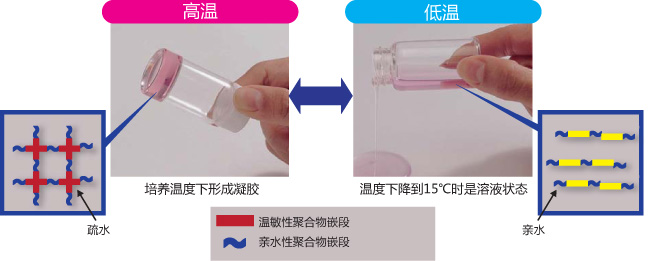
◆原理
Mebiol® Gel温敏性水凝胶与市面上其它水凝胶的不同之处在于它可以跟随温度变化进行可逆性溶胶-凝胶转换。当温度降低时,Mebiol® Gel为溶胶状态(像液体),当温度较高时形成水凝胶。在实验操作中,该特性特别有利于进行细胞操作,比如可轻松向冷却的Mebiol® Gel中加入培养基,可通过给培养瓶降温的方式进行细胞离心收集。在凝胶状态时,Mebiol Gel的高亲脂性为细胞增殖、细胞信号转导、气体质量交换以及细胞和组织对剪切力的防御等提供了非常有效的生长环境。
◆优点、特色
●易于操作
● 无毒性,生物相容性好
● 100%合成,无病原体
● 透明度高,利于细胞观察
● 性能完善
◆案例、应用
● 干细胞和多能干细胞培养,增殖和分化
● 3D细胞培养
● 细胞移植
● 器官和组织再生
● 药物传递
● 非细胞培养应用
1. Mebiol® Gel中培养原发性肿瘤细胞
选取人肿瘤组织中的原发性肿瘤细胞进行培养该技术能够鉴定来自患者的原发性肿瘤细胞的表征,因此可根据其主要细胞化学敏感性,恶性肿瘤,转移酶活性和其它参数对患者的治疗进行评估。在胶原或者3D凝胶中培养原发性肿瘤细胞,纤维细胞的过度生长可能对其产生抑制作用。而成纤维细胞在Mebiol® Gel中不容易增殖,因此能选择性增殖原代肿瘤细胞,以便后续进一步分析鉴别。
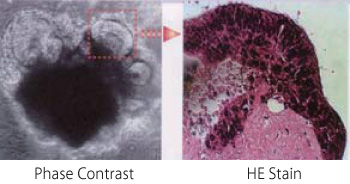
图 1:人体癌变结肠组织Mebiol® Gel培养10天。
(提供者:Dr. S. Kubota, Dept. of General Surgery, St.Marianna University School of Medicine)
人结肠癌组织在Mebiol® Gel培养10天。只有原发性肿瘤细胞中Mebiol® Gel中增殖。
成纤维细胞在Mebiol® Gel中生长受到抑制,而在胶原蛋白和其它许多3D凝胶培养基质中,长满成纤维细胞,阻止癌细胞的增殖。
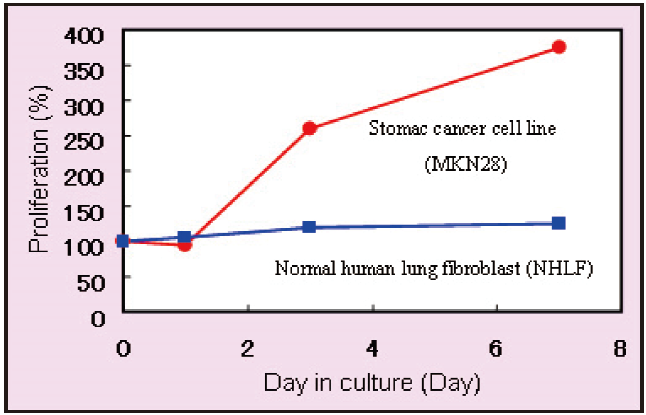
图 2:细胞生长曲线
2. 干细胞培养
猕猴胚胎干细胞用不含LIF的Mebiol® Gel培养(右图),和2D饲养层培养(左图)相比,发现形态学和碱性磷酸酶染色均未分化。
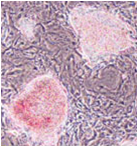
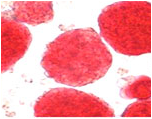
图 3
左图:2D 饲养层培养。
右图:不含LIF的3D Mebiol® Gel培养(7天)。
提供者:Dr. K. Hishikawa, Dept of Clinical Renal Regeneration, University of Tokyo.
猕猴(灵长类)胚胎干细胞在Mebiol Gel® 培养,碱性磷酸酶染色表现强阳性,表明未分化。
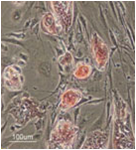
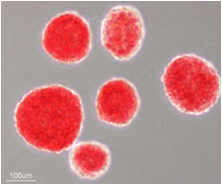
图 4
左图:2D 饲养层培养。
右图:不含LF的3D Mebiol® Gel培养(5天)。
3.球状体形成
Mebiol® Gel 可支持肿瘤细胞系和iPS细胞形成球体。
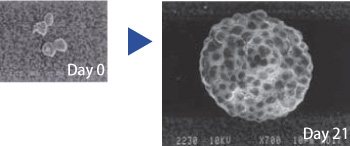
图 5:粘液表皮样癌(胆管癌)衍生细胞系在Mebiol® Gel中形成球状体。
(提供者: Dr. S. Kubota, Dept. of General Surgery, St. Marianna University School of Medicine)
4. 保持组织结构
Mebiol® Gel提供的环境,有利于维护组织结构在长期培养。

图 6
左图:正常结肠黏膜组织在Mebiol® Gel 中培养7天后。
右图:转移性肝癌组织在Mebiol® Gel 中培养21天后。
(提供者:Dr. S. Kubota, Dept. of General Surgery, St. Marianna University School of Medicine)
5. 体干细胞的选择性分离培养(小鼠胚胎皮肤源)
Epithelial Stem Cells from Dermis by a Three-dimensional Culture System” Journal of Cellular Biochemistry, 98 (1), 174-184 (2006)
6. 体外3-D软骨细胞培养再生软骨组织
Chondrocytes Containing Growth Factors in a Novel Thermoreversible Gelation Polymer Scaffold” Tissue Engineering, 12 (5), 1237-1245 (2006)
7. 体外3-D培养人细胞间质干细胞(hMSC)进行骨诱导
“Gene expression profile of human mesenchymal stem cells during osteogenesis in three-dimensional thermoreversible gelation polymer” Biochem. Biophys. Res. Commun., 317, 1103-1107 (2004).
8. 人类肝细胞3-D培养生产丙型肝炎病毒(HCV)
“Production of infectious hepatitis C virus particles in three-dimensional cultures of the cell line carrying the genome-length dicistronic viral RNA of genotype 1b“ Virology, 351 (2), 381-392 (2006)
9. 通过局部加热进行通道控制(芯片细胞分选系统)
“On-Chip Cell Sorting System Using Laser-Induced Heating of a Thermoreversible Gelation Polymer to Control Flow”, Y. Shirasaki, J. Tanaka, H. Makazu, K. Tashiro, S. Shoji, S. Tsukita, T. Funatsu,Anal. Chem., 78, 695-701 (2006)
更多产品的相关信息查看相关单页:温敏性水凝胶
 |
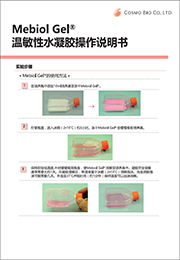 |
| 说明书 | 中文说明书 |
常见问题
◆关于Mebiol Gel的物理性能问题
Q: 当温度高于37℃(或甚至更高高达60℃),凝胶会发生什么情况?
A: 随着温度升高,凝胶会变得更硬(更凝聚)。
Q: 凝胶在2℃〜37℃是什么状态?凝胶变为溶液状态的精确温度是多少?
A: 溶胶 – 凝胶转变温度为ca.20℃
Q: 二氧化碳气体和营养物是如何提供给细胞?他们能在凝胶状态溶入细胞吗?
A: 培养基中的营养和二氧化碳可由凝胶扩散进入细胞。
Q: 当Mebiol Gel®在凝胶状态下,细胞被水凝胶包围。是否有足够的空间供细胞生长?
A: Mebiol Gel的交联点是可逆的,即使在凝胶状态(即37°C)下也一样。周边凝胶可以根据细胞的生长改变
形状而没有任何间隙/空间。
Q: 收获细胞时(溶液状态),细胞是否会发生损伤?
A: 不会
Q: 当细胞生长接触到水凝胶边缘时,是否会产生阻力?
A: 不会
Q: 可以用Mebiol Gel®来培养人肺上皮细胞吗?是否有相关研究数据?
A: 我们暂时没有相关研究数据。
Q: 在适当温度下Mebiol Gel® 从溶液转化为凝胶需要多长时间?
A: 3 msec(毫秒)
Q: 当温度在15-25℃ 时,Mebiol Gel® 是怎样一种状态?
A: 当处于转变温度时,溶液和凝胶两种状态同时存在(中间状态)。
Q: 凝胶在细胞培养条件下(37℃)的空隙有多大?
A: 非常抱歉,我们没有凝胶的孔隙率的数据,但是下面文章的讨论部分“不同的材料凝胶扩散速度”有相关
信息。
Takao et al., Novel drug delivery system using thermoreversible gelation polymer for malignant
glioma Journal of Neuro-Oncology (2005)
通常当凝胶浓度低,凝胶在材料中的“扩散速度”较高。这意味着当凝胶浓度低时,凝胶的孔隙率也较高。
然而,当凝胶浓度过低比如5%时,凝胶无法形成。
Q: 0°C-60°C是什么状态?凝胶相可逆的温度范围是?
A: 0°C-15°C: Sol溶液
15°C-20°C: 溶液和凝胶的中间状态
20°C: 溶胶-凝胶转变温度
高于 20°C: Gel凝胶
高于 37°C: 随温度升高,凝胶会变得更硬。
Q: 凝胶在37°C时的结构强度是多少??
A: 请参考以下文献。
Yoshioka H et al, A Synthetic Hydrogel with Thermoreversible Galation and Rheological Properties,
Journal of Macromolecular Science, Part A: Pure and Applied Chemistry Volume 31, Issue 1, 1994
Q: 水凝胶有孔吗?
A: 水凝胶中没有间隙和孔。
Q: 凝胶能透过CO2, N2 和 O2吗?
A: 能。
Q: 溶胶-凝胶状态可以重复转换多少次?
A: 溶胶-凝胶状态转换可以重复直到Mebiol凝胶化学分解。溶胶-凝胶重复转换的极限取决于稀释后的温度
或氧浓度。通常情况下,在冰箱能稳定存储1-2个月,长期储存,多孔板中分装的液体保持在-20°C至-80°C。
Q: 营养物分子量多少可以进入凝胶中?扩散距离与分子量的相关性是?
A: 可以在37℃通过凝胶并扩散的最大粒径分子量大约10,000-90,000(确切大小未知)。分子量的粒径数上千
如1,000-9,000,不存在通过凝胶扩散的问题,但大于此数值,则存在问题。 如果分子大小较小,扩散距离
将更长。
◆关于Mebiol Gel细胞兼容问题
Q: 当细胞在37℃生长时,我们可以更换培养基吗?
A: 37℃时,凝胶不会在水中大量溶解。因此,你可以使培养基和凝胶分层,然后更换分层后的培养基。
Q: 当Mebiol Gel®在凝胶状态下,细胞被水凝胶包围。是否有足够的空间供细胞生长?
A: Mebiol Gel的交联点是可逆的,即使在凝胶状态(即37°C)下也一样。周边凝胶可以根据细胞的生长改变
形状而没有任何间隙/空间。
Q: 凝胶适合T细胞或MSC细胞的培养吗?
A: 我们没有Mebiol gel培养T细胞的数据;关于MSC细胞,请参考以下文章:
Yuguo Lei et al., PNAS PLUS E5039–E5048 doi: 10.1073/pnas.1309408110
Q: 收获细胞时(溶液状态),细胞是否会发生损伤?
A: 不会
Q: 当细胞生长接触到水凝胶边缘时,是否会产生阻力?
A: 不会
Q: Mebiol Gel® 已成功培养的细胞有哪些?
A: 信息请见产品相关参考文献
Q: Mebiol Gel® 可用于培养肠细胞吗?有没有数据?
A: 我们暂时没有相关研究数据。
Q: Mebiol Gel® 可以用于FACS (流式细胞仪)吗?凝胶必须在哪种状态?
A: 在溶液状态下(低温),Mebiol Gel® 可以用于FACS。
Q: Mebiol Gel®可在体内使用吗?它在小鼠体内可以保留多久?
A: 可用于体内(不可用于人)。Mebiol Gel® 以凝胶形式在大鼠脑内保留超过28天。您可以参考以下文章,了解
更多信息。
T. Ozeki, K. Hashizawa, D. Kaneko, Y. Imai, H. Okada, “Treatment of rat brain tumors using
sustained-release of camptothecin from poly(lactic-co-glycolic acid) microspheres in a
thermoreversible hydrogel”, Chem. Pharm. Bull. 58 (9), 1142-1147 (2010)
Q: 可以用Mebiol Gel®来培养人肺上皮细胞吗?是否有相关研究数据?
A: 我们暂时没有相关研究数据。
Q: Mebiol Gel®会对某些细胞有毒性吗?如果有,是哪些细胞?
A: Mebiol Gel® 对细胞无毒性。
Q: 是否有Mebiol Gel® 用于甲状腺细胞(正常或肿瘤)的数据?
A: 有,请参考以下:
Production of hepatitis C viruses (HCV) by 3-D culture of human hepatocyte cell line・“Production
of infectious hepatitis C virus particles in three-dimensional cultures of the cell line carrying the
genome-length dicistronic viral RNA of genotype 1b“ Virology, 351 (2), 381-392 (2006)"
◆其他问题
Q: Mebiol Gel® 的有效期是多久?
A: 生产后约2年有效。
Q: 开封使用后,剩余的凝胶可保存多久?
A: 大约可保存1个月,如较长储存,需-20℃或-80℃冷冻。
Q: 我对Mebiol Gel®很感兴趣,请问能否提供样品试用?
A: 抱歉,我们无法提供Mebiol Gel®样品试用。
Q: Mebiol Gel® 如何消毒?在凝胶内可能存在生物活体吗?
A: 通过EOG杀菌。在凝胶中不会有任何生物体。
Q: 10ml 和 50ml的Mebiol Gel® 产品需要使用何种规格的培养瓶?
A: 分别用T-25 和 T-75 培养瓶
Q: 我可以用20%凝胶浓度代替10%储存吗?我需要将它用于不同类型的培养基。
A: 可以用20%凝胶浓度代替10%储存。但是,请注意,20%的高浓度下,即使是低温,凝胶粘性也非常高,并
具有低流动性。
Q: Mebiol Gel® (MBG-PMW20-1001) 可溶于10ml 培养基,它可以溶于更大体积的培养基吗?
A: 我们建议您将10 ml规格的Mebiol Gel® 溶于10 ml培养基中。(同样,使用50 ml规格的Mebiol Gel® 需溶
于50 ml培养基)如果您Mebiol Gel® 溶液浓度太低,可能无法形成凝胶状态。比如,如果将10 ml规格
Mebiol Gel® 溶于20 ml培养基,则无法形成胶凝。
Q: 每只Mebiol Gel® 含有多少g产品?
A: 10ml规格, 含 1.0g Mebiol Gel;50ml 规格,含5.0g Mebiol Gel。
Q: 对于5g(50ml)/瓶的包装,我想将它分成更小的规格,需要如何操作?我不希望用任何的培养基溶解后再
分装,只想分装PNIPAAm-PEG本身。然后用不同的培养基溶解分装后的试剂。
A: 理想的情况是将Mebiol Gel®在液态下等分,并保存于冰箱中(-80℃)。用普通溶剂(如PBS)溶解
Mebiol Gel® #MBG-PMW20-5005 (5g),然后进行分装。并保存在冰箱中。请准备5x浓度的培养基其他
成分,按照4:1比例添加到分装的Mebiol Gel中。
Q: Mebiol Gel粉末能在室温中保存吗?
A: 能。Mebiol Gel粉末可在室温中保存。
Q: 粉色片剂是什么?
A: 氧气检测剂。与Mebiol Gel®一同能提供氧气和水分吸收。它们不是产品的一部分。
细胞培养和组织再生
|
研究领域 |
Publication |
Pubmed ID (PMID) |
|
干细胞(人类多能干细胞 (hPSC)增殖和分化) |
A fully defined and scalable 3D culture system for human pluripotent stem cell expansion and differentiation. Lei Y, Schaffer DV. Proc Natl Acad Sci U S A. 2013 Dec 24;110(52):E5039-48. doi: 10.1073/pnas.1309408110. Epub 2013 Nov 18.PMID: 24248365 |
24248365 |
|
干细胞(人类多能干细胞(HPSC)线扩建和分化) |
An Integrated Miniature Bioprocessing for Personalized Human Induced Pluripotent Stem Cell Expansion and Differentiation into Neural Stem Cells. |
28057917 |
|
干细胞(角膜缘),综述 |
Towards the use of hydrogels in the treatment of limbal stem cell deficiency Bernice Wright, Shengli Mi, Che J. Connon Drug Discovery Today, Volume 18, Issues 12, January 2013, Pages 79-86 a |
22846850 |
|
细胞培养(肾囊肿的形成) |
Mxi1 influences cyst formation in three-dimensional cell culture. YJ Yook, KH Yoo, SA Song, MJ Seo, JY Ko, BH Kim, EJ Lee, E Chang, YM Woo, and JH Park BMB Rep, Mar 2012; 45(3): 189-93. |
22449707 |
|
基于细胞的ROS测定 |
Determination of Chronic Inflammatory States in Cancer Patients Using Assay of Reactive Oxygen Species Production by Neutrophils Yoko Suzuki, Satoshi Ohno, Ryuji Okuyama, Atsushi Aruga, Masakazu Yamamoto, Shigeki Miura, Hiroshi Yoshioka, Yuichi Mori, And Katsuhiko Suzuki Anticancer Res, Feb 2012; 32: 565 – 570.ROS Cell-Based Assay |
22287746 |
|
基于细胞的ROS测定 |
Effect of Green Tea Extract on Reactive Oxygen Species Produced by Neutrophils from Cancer Patients Katsuhiko Suzuki, Satoshi Ohno, Yoko Suzuki, Yumiko Ohno, Ryuji Okuyama, Atsushi Aruga, Masakazu Yamamoto, Ken-O Ishihara, Tsutomu Nozaki, Shigeki Miura, Hiroshi Yoshioka, And Yuichi Mori Anticancer Res, Jun 2012; 32: 2369 – 2375. |
22641677 |
|
生物工艺 |
Light-Patterned RNA Interference of 3D-Cultured Human Embryonic Stem Cells. |
27787919 |
|
胶质母细胞瘤的抽搐药物发现 |
Scalable Production of Glioblastoma Tumor-initiating Cells in 3 Dimension Thermoreversible Hydrogels. |
27549983 |
|
骨桥蛋白的生产 |
A CD153+CD4+ T Follicular Cell Population with Cell-Senescence Features Plays a Crucial Role in Lupus Pathogenesis via Osteopontin Production |
25972477 |
|
干细胞(人类多能干细胞 (hPSC)增殖和分化) |
Developing Defined and Scalable 3D Culture Systems for Culturing Human Pluripotent Stem Cells at High Densities. |
25419247 |
|
干细胞培养,再生医学 |
Application of a Thermo-Reversible Gelation Polymer, Mebiol Gel, for Stem Cell Culture and Regenerative Medicine Kataoka K and Huh N*Journal of Stem Cell & Regenerative Medicine 2010 Vol. 6(1): p10-14 (2010) |
link |
|
器官培养 |
FGF signaling directs a center-to-pole expansion of tubulogenesis in mouse testis differentiation. Hiramatsu R, Harikae K, Tsunekawa N, Kurohmaru M, Matsuo I, Kanai Y. Development. 2010 Jan;137(2):303-12. doi: 10.1242/dev.040519. |
20040496 |
|
干细胞(角膜缘) |
Ex vivo cultivation of corneal limbal epithelial cells in a thermoreversible polymer (Mebiol Gel) and their transplantation in rabbits: an animal model. G Sitalakshmi, B Sudha, HN Madhavan, S Vinay, S Krishnakumar, Y Mori, H Yoshioka, and S Abraham Tissue Eng Part A, Feb 2009; 15(2): 407-15. |
18724830 |
|
干细胞(角膜缘) |
Limbal Stem Cells: Application in Ocular Biomedicine Review Article Geeta K. Vemuganti, Anees Fatima, Soundarya Lakshmi Madhira, Surendra Basti, Virender S. Sangwan International Review of Cell and Molecular Biology, Volume 275, 2009, Pages 133-181 |
19491055 |
|
病毒感染/复制系统 |
3D cultured immortalized human hepatocytes useful to develop drugs for blood-borne HCV Hussein Hassan Aly, Kunitada Shimotohno, Makoto Hijikata Biochemical and Biophysical Research Communications, Volume379, Issue 2, 6 February 2009, Pages 330-334 |
19103167 |
|
胚胎移植培养 |
Antagonism between Smad1 and Smad2 signaling determines the site of distal visceral endoderm formation in the mouse embryo.Yamamoto M, Beppu H, Takaoka K, Meno C, Li E, Miyazono K, Hamada H. J Cell Biol. 2009 Jan 26;184(2):323-34. doi: 10.1083/jcb.200808044. Epub 2009 Jan 19. |
19153222 |
|
肝细胞移植 |
Intraperitoneal Transplantation Of Hepatocytes Embedded In Thermoreversible Gelation Polymer (Mebiol Gel) In Acute Liver Failure Rat Model. N. Parveen, A.A. Khan, S. Baskar, M.A. Habeeb, P. Ravindra Babu, A. Samuel, Y. Hiroshi, M. Yuichi, C.M. Habibullah Hepatitis Monthly, Volume 275 8, Issue 4, Autumn, November 2008 Page S71 |
link |
|
干细胞(间充质) |
Chrondrogenic differentiation of human mesenchymal stem cells from umbilical cord blood in chemicially synthesized thermoreversible polymer. Kao, I, et al. Chinese J. Physiology, 51(4), 252-258 (2008) |
19112883 |
|
肝细胞培养 |
Serum-derived hepatitis C virus infectivity in interferon regulatory factor-7-suppressed human primary hepatocytes. Hussein H. Aly, Koichi Watashi, Makoto Hijikata, Hiroyasu Kaneko, Yasutugu Takada, Hiroto Egawa, Shinji Uemoto, Kunitada Shimotohno Journal of Hepatology, Volume 46, Issue 1, January 2007, Pages 26-36 |
17112629 |
|
干细胞(角膜缘) |
Cultivation of human corneal limbal stem cells in Mebiol gel–A thermo-reversible gelation polymer. B Sudha, HN Madhavan, G Sitalakshmi, J Malathi, S Krishnakumar, Y Mori, H Yoshioka, and S Abraham Indian J Med Res, Dec 2006; 124(6): 655-64 |
17287553 |
|
组织工程(骨) |
In vitro culture of chondrocytes in a novel thermoreversible gelation polymer scaffold containing growth factors. Yasuda A, Kojima K, Tinsley KW, Yoshioka H, Mori Y, Vacanti CA. Tissue Eng. 2006 May;12(5):1237-45. |
16771637 |
|
干细胞(上皮) |
Isolation of epithelial stem cells from dermis by a three-dimensional culture system. Medina RJ, Kataoka K, Takaishi M, Miyazaki M, Huh NH. J Cell Biochem. 2006 May 1;98(1):174-84. |
16408300 |
|
干细胞(角膜缘) |
Comparative Study on Growth Characteristics of Cadaveric Human Corneal Limbal Stem Cells in Mebiol Gel (a Synthetic Polymer) and on Human Amniotic Membrane. H.N. Madhavan, B. Sudha1, G. Sitalakshmi, S. KrishnaKumar, Y. Mori, H. Yoshioka and S. Abraham.Invest Ophthalmol Vis Sci 2006;47: E-Abstract 3033. 3033B186 |
|
|
组织再生(肝) |
Thermoreversible gelation polymer induces the emergence of hepatic stem cells in the partially injured rat liver. Nagaya M, Kubota S, Suzuki N, Akashi K, Mitaka T.Hepatology. 2006 May;43(5):1053-62. |
16628635 |
|
病毒增殖和药物筛选 |
Production of infectious hepatitis C virus particles in three-dimensional cultures of the cell line carrying the genome-length dicistronic viral RNA of genotype 1b.Murakami K, Ishii K, Ishihara Y, Yoshizaki S, Tanaka K, Gotoh Y, Aizaki H, Kohara M, Yoshioka H, Mori Y, Manabe N, Shoji I, Sata T, Bartenschlager R, Matsuura Y, Miyamura T, Suzuki T.Virology. 2006 Aug 1;351(2):381-92. Epub 2006 May 6. |
16678876 |
|
胚胎培养 |
Canonical Wnt Signaling and Its Antagonist Regulate Anterior-Posterior Axis Polarization by Guiding Cell Migration in Mouse Visceral Endoderm. Chiharu Kimura-Yoshida, Hiroshi Nakano, Daiji Okamura, Kazuki Nakao, Shigenobu Yonemura, Jose A. Belo, Shinichi Aizawa, Yasuhisa Matsui, Isao Matsuo Developmental Cell, Volume 9, Issue 5, November 2005, Pages 639-650 |
16256739 |
|
细胞在Mebiol Gel中的生长评估 |
H.N. Madhavan, J. Malathi, Patricia Rinku Joseph, Mori Yuichi, Samuel JK Abraham and Hiroshi Yoshioka. A study on the growth of continuous culture cell lines embedded in Mebiol Gel., Current Science, 87(9), 1275~77(2004). |
|
|
干细胞培养和分化 |
Gene expression profile of human mesenchymal stem cells during osteogenesis in three-dimensional thermoreversible gelation polymer. Hishikawa K, Miura S, Marumo T, Yoshioka H, Mori Y, Takato T, Fujita T. Biochem Biophys Res Commun. 2004 May 14;317(4):1103-7. |
15094382 |
|
肝再生 |
Evaluation of Thermoreversible gelation polymer for Regeneration of Focal Liver Injury. M. Nagaya, S. Kubota, N. Suzuki, M. Tadakoro, K. Akashi. Eur Surg Res, 36:95-103 (2004). |
15007262 |
|
球状培养(肿瘤) |
S. Tsukikawa, H. Matsuoka, Y. Kurahashi, Y. Konno, K. Satoh, R. Satoh, A. Isogai, K. Kimura, Y. Watanabe, S. Nakano, J. Hayashi, and S. Kubota. A new method to prepare multicellular spheroids in cancer cell lines using a thermo-reversible gelation polymer, Artifcial Organs, 27(7), 598 -604(2003). |
12823414 |
|
伤口康复 |
Wound Dressing of Newly Developed Thermo gelling Thermo reversible Hydro gel. H. Yoshioka, Y. Mori, S. Kubota , Jpn J Artif Organs, 27(2), 503 -506 (1998).(Japanese Publication- Abstract in English) |
|
|
胰岛移植 |
In Vitro Studies on a New Method for Islet Micro encapsulation Using a Thermo reversible Gelation Polymer, N-Isopropylacrylamide-Based Copolymer. S. Shimizu, M. Yamazaki, S. Kubota, T. Ozasa, H. Moriya, K. Kobayashi, M. Mikami, Y. Mori and S. Yamaguchi. Artif Organs, Vol. 20, No.11 (1996). |
8908335 |
Mebiol Gel应用——非细胞培养
|
研究领域 |
Publication |
Pubmed ID (PMID) |
|
蛋白质结晶支架 |
A Novel Approach for Protein Crystallization by a Synthetic Hydrogel with Thermoreversible Gelation Polymer. Sugiyama, et al., Cryst. Growth Des., 2013, 13(5), pp 1899-1904 |
link |
|
DNA电泳和修复支架 |
Separation and recovery of DNA fragments by electrophoresis through a thermoreversible hydrogel composed of poly (ethylene oxide) and poly (propylene oxide). Yoshioka H, Mori Y, Shimizu M. Anal Biochem. 2003 Dec 15;323(2):218-23. |
14656528 |
|
细胞分选 |
On-chip cell sorting system using laser-induced heating of a thermoreversible gelation polymer to control flow. Shirasaki Y, Tanaka J, Makazu H, Tashiro K, Shoji S, Tsukita S, Funatsu T. Anal Chem. 2006 Feb 1;78(3):695-701. |
16448041 |
|
细胞分选 |
Microfluidic cell sorter with flow switching triggered by a solgel transition of a thermo-reversible gelation polymer.Kazuto Ozaki, Hirokazu Sugino, Yoshitaka Shirasaki, Tokihiko Aoki, Takahiro Arakawa, Takashi Funatsu, Shuichi Shoji Sensors and Actuators B: Chemical, Volume 150, Issue 1, 21 September 2010, Pages 449-455 |
link |
|
DNA分子分选 |
Microfluidic active sorting of DNA molecules labeled with single quantum dots using flow switching by a hydrogel solgel transition. Mai Haneoka, Yoshitaka Shirasaki, Hirokazu Sugino, Tokihiko Aoki, Takahiro Arakawa, Kazuto Ozaki, Dong Hyun Yoon, Noriyuki Ishii, Ryo Iizuka, Shuichi Shoji, Takashi FunatsuSensors and Actuators B: Chemical, Volume 159, Issue 1, 28 November 2011, Pages 314-320 |
link |
|
药物输送 |
Novel drug delivery system using thermoreversible gelation polymer for malignant glioma.Arai T, Joki T, Akiyama M, Agawa M, Mori Y, Yoshioka H, Abe T. J Neurooncol. 2006 Mar;77(1):9-15. |
16292493 |
|
药物输送 |
Novel local drug delivery system using thermoreversible gel in combination with polymeric microspheres or liposomes.Arai T, Benny O, Joki T, Menon LG, Machluf M, Abe T, Carroll RS, Black PM.Anticancer Res. 2010 Apr;30(4):1057-64. |
20530409 |
|
细胞分选开关 |
On-Chip Cell Sorting System Using Thermoreversible Gelation Polymer. |
|
|
细胞培养药物筛选 |
Alternatives to Animal Testing and Experimentation Wakui et al. in vitro Thermoreversible Gel Disc Quantitative Assay of Rat Angiogenesis. AATEX16(2), 59-65, 2011 |
link |
Mebiol Gel 物理特性
|
研究领域 |
Publication |
Pubmed ID (PMID) |
|
物理特性 |
A synthetic hydrogel with thermoreversible gelation. II. : Effect of added salts. H. Yoshioka, M. Mikami, Y. Mori, and E. Tsuchida. J. Macromol. Sci., A31(1), 121-125 (1994). |
link |
|
物理特性 |
Thermoreversible gelation on heating and on cooling of an aqueous gelatin-poly(N-isopropylacrylamide) conjugate. , H. Yoshioka, Y. Mori, S. Tsukikawa, and S. Kubota, Polym. Adv. Tech., 9, 155-158 (1998). |
link |
|
物理特性 |
A Synthetic hydrogel with thermoreversible gelation. I. Preparation and rheological properties , H. Yoshioka, M. Mikami and Y. Mori. J.M.S- Pure Appl. Chem., A31(1), pp. 113-120 (1994). |
link |
|
物理特性 |
Preparation of Poly (N-Isopropylacrylamide)-b-Poly(Ethylene Glycol) and Calorimetric Analysis of its Aqueous Solution , H. Yoshioka, M. Mikami and Y. Mori,J.M.S- Pure Appl. Chem., A31(1), pp. 109-112 (1994). |
link |
|
物理特性 |
Endovascular treatment of experimental aneurysms using a combination of thermoreversible gelation polymer and protection devices: feasibility study. |
19687707 |
|
物理特性 |
Bio rapid prototyping by extruding/aspirating/refilling thermoreversible hydrogel. |
20811123 |
|
物理特性 |
A synthetic hydrogel with thermoreversible gelation. III. : An NMR study of the Sol-Gel transition. H. Yoshioka, Y. Mori and James A. Cushman. Polym. Adv. Tech., 5, pp. 122-127 (1994). |
link |
